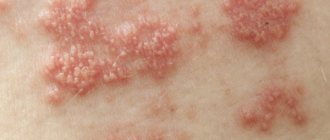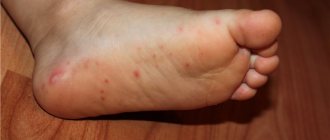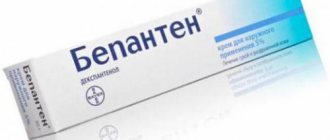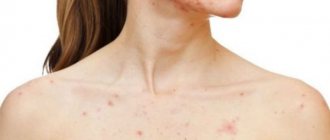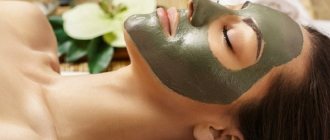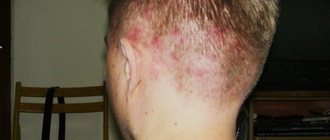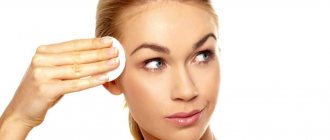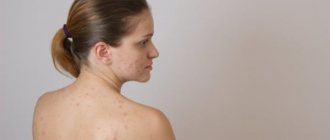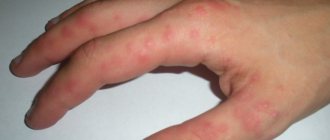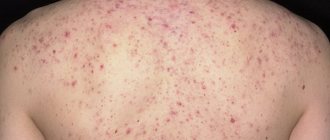If water pimples occur on the legs, this may be a sign of conditions and diseases such as allergies, viral infections, fungal infections, gastrointestinal dysfunction, and the introduction of bacteria. The rash is accompanied by itching, fever, and unpleasant foot odor. At the first symptoms, you should consult a doctor who will prescribe medications and alternative medicine, as well as give preventive recommendations.
Allergic reaction
The main difference between an allergic rash and other types of blisters is that it goes away as soon as the allergen is eliminated.
Watery pimples on the legs appear due to an immune response to irritants. The localization of the rash spreads over the entire surface of the lower extremities. Pimples appear against a background of red or pink spots and are very itchy. The reasons are the following factors:
- synthetic fabric socks or tights;
- woolen items;
- low-quality materials from which the shoes are made;
- nutritional supplements;
- flowering period of plants;
- poultry feathers;
- dry food for fish.
Why do pimples appear?
The main factors that cause acne between the toes are:
- Scabies mite. Infection with scabies occurs as a result of bodily contact with a sick person or his clothing that has not been sanitized. Red, watery blisters appear on the toes and hands. In advanced cases, the infection spreads to other parts of the body. Pimples itch very much at night, when the mite is active.
- Allergic reaction. It is found on the legs of children and adults. Occurs as a result of an immune response to an allergen - preservatives in food, clothing made from unnatural materials, medications, foot cosmetics. A red or watery blister forms on the affected skin, accompanied by severe itching.
- Hyperhidrosis. If small pimples filled with clear fluid appear between your toes, this may be skin irritation due to excessive sweating. The condition is provoked by tight socks in the hot season and shoes with poor ventilation. Hyperhidrosis also occurs due to a hormonal disorder, vegetoneurosis.
- Uncomfortable shoes. Narrow and tight shoes cause compression of the toes, resulting in chafing - a small transparent blister that hurts a lot. Redness may form around the pimple.
- Psoriasis. It is characterized by the appearance of large raised pimples, severe itching and peeling. Most often it is formed due to stress or emotional shock.
- Fungi. Small white pimples appear. Accompanied by a floury type of peeling, the formation of cracks and wounds between the fingers, roughening of the skin, and brittle nails. You can catch the fungus in bathhouses, on the beach, or in a hostel. especially when using other people's personal hygiene items.
READ ALSO: Red dots on the tongue: causes and treatment
Home therapy
At home, you can use a ready-made calendula infusion.
If watery pimples become inflamed and itchy, they are treated with an alcohol tincture of calendula, which dries out the skin. The white abscess can be cauterized with a pharmaceutical preparation or prepared independently. Recipe:
- Take 10-20 g of inflorescences and pour 200-300 ml of vodka.
- Leave for 7 days in a dark place, shaking occasionally.
- After the expiration date, moisten a cotton pad in the product, squeeze a little and wipe the problem area.
Aloe juice is effective when used as follows:
- Take a freshly cut leaf, wash it, cut it lengthwise.
- Scrape out the pulp, wrap in cheesecloth and squeeze out the juice.
- Moisten a cotton swab and treat pimples.
Severe itching goes away if you dissolve several crystals of potassium permanganate in a glass of water and wipe the skin. It should be remembered that too concentrated a solution of potassium permanganate can cause skin burns. The use of St. John's wort is effective. The decoction can be taken orally and used as a foot bath. Preparation:
- Take 5-10 g of herb and pour 200 ml of hot water.
- Let it brew for 15-20 minutes, cool, filter.
- Take 10 ml orally 3 times. in a day.
- Dilute 200 ml of decoction in a bowl of water and soak your feet for 20 minutes.
So, what are acne on the legs?
Small white pimples on the legs, especially above the shins, can appear from dry skin and be a consequence of simple irritation from constantly wearing tight trousers, tights, etc. Unlike other parts of the body, heat exchange in the legs is almost always disrupted: at the same time, we constantly cover our legs with something, thereby overheating them, and overcooling them - for example, on the street.
We suggest you familiarize yourself with Red spot on the forehead of an adult
Varicose veins contribute to dry skin and increased inflammatory processes. This is especially true for pimples on the lower legs - this area suffers more than others from dryness and itching due to varicose veins.
Red pimples on the legs can occur as a result of inaccurate depilation, when the hair turns the direction of its growth and grows inside the hair follicle. This is extremely unpleasant; acne can fester and actively break out, forming abscesses.
If you find that a red pimple has a subcutaneous base, is enlarged in size and is very painful, or, on the contrary, is completely devoid of sensitivity, be sure to consult a doctor: most likely you will need the help of a surgeon.
Photo – 3 Red pimples on the legs can occur due to inaccurate depilation
Itchy, watery pimples are a clear sign of some kind of infection. Pay attention to other areas of the body: if acne is localized not only on the legs, it is likely that you have chickenpox, rubella or measles. Watery pimples on the toes may be a sign of fungus. Localized on the lower legs - eczema or even forms of psoriasis. Do not treat water acne on your own; if the first symptoms occur, consult a doctor.
Treatment
The causes of acne on the legs in men, women and children can be of various etiologies, so making a correct diagnosis on your own is quite difficult. Each type of rash requires its own approach and its own treatment methods. It is best to consult a dermatologist, who, after examining and taking tests, will prescribe exactly the medications that will help cope with your problem.
Before consulting a doctor, you can take the following measures:
- use underwear and clothing made from natural fibers adjacent to problem areas of the skin that are appropriate for your size and weather to avoid overheating or hypothermia;
- try changing the care products and washing powder you use to wash your clothes;
- acne rashes can be lubricated with salicylic alcohol or ointment;
- Watery pimples can be wiped with a solution of manganese;
- for purulent rashes, they can be wiped with calendula tincture, aloe or celandine juice;
- Do not try to squeeze out the contents of pimples.
For dry acne on the legs, you should use hygiene products that do not dry out the skin. When washing, you can gently rub your feet with a washcloth to get rid of the stratum corneum, and then lubricate the skin with cream. When acne on the legs itches, it is permissible to use baths and compresses with string, calendula, chamomile, oak bark or sage.
If within ten days after home treatment your legs remain covered in acne, the disease progresses, you should make an appointment with a dermatologist to accurately determine the cause of the rash. In some cases, to get rid of acne you will have to use an integrated approach, which will not be limited to local effects only, but will be aimed at improving the health of the entire body.
What to do if water acne appears
As we wrote above, the main thing is not to ignore their appearance and not expect them to go away on their own. The appearance of such acne on the legs can only be the beginning, and if no action is taken, then this type of rash will continue to appear not only on the limbs, but throughout the body.
Next, you just need to contact a dermatologist. Despite the fact that acne itself does not initially look scary, self-treatment is not recommended. The fact is that the cause of the rash is not due to skin problems, and therefore most topical products will simply be useless. on the other hand, for example, a white clay mask does not hurt acne, and will not only remove acne, but also rejuvenate the skin.
Let us note that acne can go away with self-treatment, however, firstly, a relapse, and a more complicated one, will not be long in coming, and secondly, the cause of the rash will not be cured, so there is no need to talk about a positive outcome of self-treatment.
As for visiting a doctor, here the patient, firstly, will be given an accurate diagnosis, which will further determine the treatment regimen, and secondly, medications will be selected. The fact is that some medications can be quite toxic, such as roccutane, so their use should be under the strict supervision of the attending physician.
In addition, drugs are selected depending on the individual characteristics of the patient’s body.
What blisters may indicate
Watery blisters that appear on the feet can have different origins, differ in size, symptoms, location, be a manifestation of a disease or be a consequence of an external factor.
Vesicles with transparent or translucent exudate inside have signs of inflammation, can itch, burn, be accompanied by pain on palpation, be dense or easily wounded, be supplemented with elements of a rash, and manifest as multiple or single rashes. Depends on the reason why they appeared. There are two ways for blisters to appear on the feet:
Internal factors:
- An allergic reaction on the feet can develop due to the influence of various irritants. This could be food, medicine, cosmetics, socks or shoes. Watery allergy rashes are accompanied by redness and itching;
- Hyperhidrosis manifests itself in increased sweating of the feet. Due to the constant moisture of the skin, small pimples with liquid inside appear on the surface. The causes of pathology in adults are different: from wearing shoes out of season to the presence of a malignant tumor in the body. In children, the phenomenon is called miliaria. It appears when caring parents “wrap up” the child too much. The rash on the sole with hyperhidrosis comes in three types: red, papular and crystalline. The latter has the appearance of white or colorless small pimples, which, when bursting, become prone to suppuration. Miliaria rubra appears in the form of blisters up to 2 mm and is accompanied by itching. The papular type of hyperhidrosis is characterized by severe itching, burning, dry flaky skin;
- Diabetes mellitus can lead to a lot of complications, including blisters on the toes and soles, which are called diabetic pemphigus. The problem is expressed in the formation of blisters (bulls) with liquid, similar to burns. The pathology is typical for people with type 3-4 disease, diabetic neuropathy. The bullae do not cause pain and do not require treatment other than blood sugar control;
- Vitamin deficiency is a lack of vitamins in the body. The rashes are seasonal and appear in the winter-spring period;
- Eczema affects the skin in various parts of the body and is characterized by many varieties. Tilotic (callous-like) and dyshidrotic types of skin disease are localized on the feet. With callous eczema, keratinization is observed on the soles and heels, and in the dyshidrotic form, itchy vesicles may appear on the feet and toes. They are located deep under the skin. Blister rashes measure 5-7 mm and are filled with liquid;
- Chickenpox is a viral disease, one of the symptoms of which is the appearance of water pimples on the skin, accompanied by pain and itching. Vesicles with chickenpox tend to burst and transform into ulcers. If an infection joins the sores, there is a risk of complications in which the wounds fill with pus and leave a deep mark after healing. The soles of the feet are rarely affected by this viral infection, but the skin between the toes and on the back of the feet develops a rash;
- Erysipelas is an infectious disease that has several varieties. The formation of blisters is characterized by the erythematous-bullous and bullous-hemorrhagic form of the disease. The cause of foot damage is often heel cracks, which are open gates for the penetration of streptococcus, which is the causative agent of the pathology;
- The fungal infection may affect the nails or spread to the foot. There are three forms of mycosis: squamous, interdigital and vesicular. In the first type, blisters appear; after they burst, dense keratinization is formed. The second type of infection is characterized by the appearance of small, weeping blisters between the fingers, gradually affecting all folds from the little finger to the thumb. In the vesicular form, the fungus penetrates the skin and dropsy appears. It becomes difficult to step on the sole without damaging the vesicles, and as a result of a violation of their integrity, ulcers form;
- Scabies is a contagious skin disease. The cause is the scabies mite. The parasite makes subcutaneous passages, causing the formation of tubercles and purulent pimples. In addition to other parts of the body, the mite is localized on the lateral and inner areas of the feet;
- viral pemphigus is an infectious disease that affects the skin and mucous membranes. Blisters with a red rim are filled with transparent exudate, they hurt and itch. Once they burst, they form an ulcer.
We suggest you find out how long lung surgery lasts. Lung removal and lung surgery for cancer
External reasons:
- Watery calluses on the feet appear as a result of wearing uncomfortable or rough shoes. The blisters, when pressed on by the walls of the shoes, burst and form painful wounds. Thin skin may peel off from the site of injury, exposing the inflamed dermal layer;
- insect bites often cause the formation of vesicles on the body and skin of the feet;
- burns of any origin (solar, thermal, chemical, electrical) cause the formation of blisters on the epidermis;
- cryodestruction is a method of removing warts, including plantar warts. After the procedure, the formation of blisters is often observed, which later burst and become crusty;
- the effect of chemicals on the body can manifest itself as a rash in the form of blisters.
Reasons for appearance
Any kind of pimples, comedones, acne and dropsy on the skin bring not only discomfort and pain, but also make it less attractive to others. Watery pimples on the body and legs may indicate certain pathological processes that have arisen in the body, or a decrease in immune defense.
There are many factors that can cause watery acne. But the main one is sensitive skin. In general, the reasons why water pimples appear on the legs can be divided into two categories - external and internal.
The most common root cause of their appearance in women is shaving. Often the fair sex faces the problem of irritation after shaving in the form of flaking, severe itching, burning and small rashes. Therefore, dermatologists advise adhering to certain rules of depilation or even changing the chosen shaving method.
READ ALSO: Rashes on the labia - photos, causes, causes and treatment of the rash
The greatest irritation is caused by depilation using wax and depilator. However, even banal shaving with a machine can provoke such a consequence. This may be due to an old, dull razor, dry shaving, or not using emollients after shaving.
Internal causes of water acne include:
- colds;
- decreased immune defense;
- exacerbation of chronic diseases;
- lack of certain vitamins and microelements;
- allergic reaction;
- disturbances in the functioning of the digestive system, which often leads to acne.
Very often, dropsy appears precisely in the cold season, since it is at this time that viral diseases and colds become significantly worse and immunity is significantly reduced. Also, pimples on the feet and hips can become a symptom of an allergy to the fabric of clothing, to the skincare products used, as well as to other external irritants.
Possible external causes of acne on the legs:
- irritation after shaving
- incorrectly selected skincare products;
- severe dry skin and neglect of moisturizing cosmetics;
- poor hygiene or lack thereof;
- irritation on the fabric of clothing or as a result of exposure to sunlight in the summer.
Dermatological diseases cannot be left aside. Of these, the most common are:
- demodicosis, which causes itching, blisters, inflammation in the body;
- shingles, which is characterized by the appearance of watery pimples all over the body;
- herpes - most often the hands, face, lips are affected;
- fungus.
In recent decades, cases of rashes as a result of unstable functioning of the nervous system have become more frequent. Therefore, dermatologists often notice all kinds of rashes after severe stress, depression, nervous shock, and so on.
In any case, if you notice this kind of rash on your body, you should consult a dermatologist. Because if pimples appear on your hands, fingers, body or legs that cause discomfort, this may be an alarming sign. But the root cause of their appearance can be much more serious and more dangerous to human health and even life. Moreover, there are many reasons for the appearance of dropsy.
Causes of dropsy on the feet
Experts often note incorrectly selected shoes as a separate cause of dropsy. Usually those who prefer shoes with heels complain about this problem. It is also possible that acne can form on the feet due to the wrong choice of shoes - the wrong size, synthetic inner filler, uncomfortable shoe shape, and so on.
Therefore, doctors advise choosing first of all comfortable shoes, preferably made from natural fabrics. It is worth paying attention to socks. It is better to buy cotton socks, but you need to change them every day for clean ones so as not to provoke the appearance of fungus, which can also manifest itself in the form of small watery pimples on the toes and on the sides of the feet.
Another common cause of watery feet is hyperhidrosis. This is a very popular problem today for both men and women. Therefore, it is necessary to use various means to reduce the amount of sweat produced:
- deodorants and talc for feet;
- remedies for hyperhidrosis - Teimur paste, Dry Dry, etc.
Dermatologists recommend washing your feet with tar soap, as it does an excellent job of removing excess oil.
Dropsy between legs
Pimples between the legs, on the inner thighs, bring a lot of discomfort. In addition, it is not so easy to get rid of them, since the dermis in this place is particularly sensitive, thin and often subject to friction.
Blisters on the soles of the feet from external influences
What to do if the cause of unpleasant bubbles is external irritants:
- For sunburn. Small water pimples on the legs and throughout the body may appear after long walks or exposure to direct sunlight. Pimples, large and small, from the burn not only itch, but also hurt. You can't pierce them! Use anti-burn products that reduce pain, prevent infection from developing and heal wounds.
- Insect bites. Such blisters threaten not only redness, itching, but also swelling of the skin. To eliminate these symptoms, you will need antihistamines for oral and external use. You should not scratch the rash, otherwise there is a risk of complicating the treatment and health of the skin.
How to treat allergies
When experiencing skin rashes, many people look at their hands with horror, begin to panic and wonder what to do. There is no need to panic. First of all, to avoid complications, you need to start washing your hands with bactericidal, preferably liquid soap.
Household chemicals often lead to similar phenomena. The skin of the hands is sensitive and cannot withstand the onslaught of chemicals, as well as frequent contact with water. It is better to wear gloves when washing and using powders.
For itching and burning, you can use skin-soothing mash, baths with the addition of chamomile, or string. Baths with peat oxidate and a water temperature of 37°C help well. You need to repeat the procedure for several days. If a scabies mite has penetrated the skin, you cannot avoid treating the skin with Spregal, Benzyl benzoate. In this case, it is necessary to disinfect all things, treat them thermally or even chemically.
READ ALSO: Rashes on a child’s body and itching: what to do if the skin with a rash itches on the back, neck and feet
Allergies should not be confused with scabies. These are completely different diseases that differ in symptoms and treatment. It is best to seek help from a doctor immediately.
What can they be a symptom of and how to recognize it
If there is a hormonal imbalance, then this contributes not only to the appearance of red slings on the thighs, but also to mood swings. Women also often experience uncharacteristic discharge.
If pimples appear on your legs and itch, this often indicates an allergy. If left untreated, the spots merge together.
We suggest you familiarize yourself with Growths between the toes, what are they?
Respiratory diseases cause corresponding symptoms: cough, runny nose, sneezing. It is also worth reconsidering your diet.
Prevention
Prevention in the treatment of watery acne on the legs is no less important than the treatment itself.
The first thing to start with is cleansing the body. And this applies to absolutely any patient. To do this, you will have to reconsider your diet, eliminating all harmful foods from it.
On the contrary, the diet includes foods that contain large quantities of vitamins, minerals, and nutrients. Naturally, much attention is paid to fresh fruits and vegetables.
Further, the consumption of fatty, fried, smoked foods should be kept to a minimum, and ideally, it would be good to completely get rid of them. In addition, herbal medicine for acne also helps a lot, the principles of which can be found on our website.
The diet should consist of dairy products at least twice a week, this will normalize and maintain the functioning of the stomach.
Let's add a very interesting, but controversial approach - sunbathing. This is simply an opportunity to sunbathe or visit a solarium. Human skin should receive vitamin D, and the easiest and healthiest way to get it is to tan. However, there are also pitfalls here. So, for example, excessive exposure to ultraviolet radiation can provoke melanoma.
In some cases, it is possible to use a scrub based on sea salt. This option is also quite ambiguous, since if you have a rash, you cannot use a scrub, so it is considered only as a means of prevention, and even if you have a rash, you should immediately discard it.
Watery pimples of various origins on the legs are a problem faced by both men and women of different ages.
Their formation can be caused by dry skin, allergic reactions to poor-quality shoes and clothing, or the development of skin diseases. For people over 25 years of age, acne on the legs is more common than for younger people.
Eczema
The causes of this disease have not been clarified to this day, so it is not yet possible to cure it completely. It can be provoked by: dysbacteriosis, deficiency or excess of vitamins, malfunctions of the digestive organs, kidneys, weakened immunity and other factors. Eczema spreads, most often, on the extremities, manifesting itself first as itchy redness, and then as blisters on the affected areas.
Another cause of watery pimples on your skin may be eczema. With this disease, the rash affects not only the arms and legs but also many parts of the body such as the neck, face, stomach or back. A progressive disease is caused by the isolated influence of external factors. Let's look at some of them:
- Severely decreased body reactivity
- Psycho-emotional stress
- Immune deficiency of the body
- Diseases of the gastrointestinal tract
- Thermal and chemical burns
- Various skin lesions
- Kidney failure, etc.
In most cases, watery pimples can appear in areas such as an open wound, trophic ulcers and very deep cuts and scrapes.
Etiology of rashes on the legs
There can be many reasons for the appearance of acne on the legs. They are observed in both men and women. Why do rashes occur on my legs? They can be provoked by:
- allergic reactions to care products, food, laundry detergents;
- hormonal disorders;
- synthetic clothing that prevents air flow and causes profuse sweating;
- incorrectly selected hygiene products - soap, shower gel, cream;
- swimming in polluted reservoirs and pools where the water is intensively chlorinated;
- individual reaction to insect bites;
- weakening of immune defense due to colds;
- stress;
- avitaminosis;
- skin viral diseases;
- first manifestations of psoriasis;
- hemorrhagic vasculitis;
- scabies mite damage;
- blood sugar spike.
Acne on women's legs often occurs after depilation as a reaction to a depilatory cream that irritates the skin. Using a razor sometimes causes damage to the skin and also causes acne. Epilation using wax or an epilator provokes ingrown hairs, accompanied by redness and discomfort.
Acne on the legs of men is often the result of neglecting proper care and using low-quality shower gels. Many men trigger such rashes because they do not consider them to be something serious. If we are talking about children, pimples on the legs can also be caused by prickly heat, the initial stages of chicken pox or measles, and allergies.

